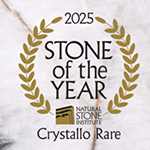Responsible Manufacturing: Best Practices for Quarriers and Fabricators
The ultimate validation of a company’s responsible production practices in the natural stone industry is certification to the Natural Stone Sustainability Standard. This multi-attribute industry standard defines metrics for environmental, ecological, human health, and social governance. Certified companies have third party verified compliance with these continuously improved metrics.
Natural stone quarriers and fabricators are encouraged to review these best practices to improve their own performance ahead of going through the certification process.
Water
Intent: Ensuring the responsible use and disposal of water.
Best Practices: Recycle water used in production processes. Ensure that any water being released back into the environment is safe. Some companies are recycling over 95% of the water used in their facilities.
Intent: Ensuring the responsible use and disposal of water.
Best Practices: Recycle water used in production processes. Ensure that any water being released back into the environment is safe. Some companies are recycling over 95% of the water used in their facilities.
Custody & Transportation
Intent: Understanding the chain of custody from raw material extraction at the quarry, to fabrication, and through distribution and final installation.
Best Practices: The largest environmental impact in the production of natural stone is its transportation. Natural stone is heavy and there are limits to the load size. A good first step is simply defining the chain of custody from the quarry to the final jobsite. Then you can take steps to reduce the miles each material travels by eliminating stops and/or choosing closer destinations. Also consider the transportation method. Boats and trains have lower environmental impacts than trucks and planes.
Intent: Understanding the chain of custody from raw material extraction at the quarry, to fabrication, and through distribution and final installation.
Best Practices: The largest environmental impact in the production of natural stone is its transportation. Natural stone is heavy and there are limits to the load size. A good first step is simply defining the chain of custody from the quarry to the final jobsite. Then you can take steps to reduce the miles each material travels by eliminating stops and/or choosing closer destinations. Also consider the transportation method. Boats and trains have lower environmental impacts than trucks and planes.
Site Management
Intent: Mitigating hazards in order to reduce risk and keep visitors and employees safe.
Best Practices: Proper signage and definition of potentially hazardous areas will go a long way in ensuring the safety of people at your quarry and fabrication facilities. Suppressing dust is also a key part of this section of the standard as this will reduce the risk of silicosis.
Intent: Mitigating hazards in order to reduce risk and keep visitors and employees safe.
Best Practices: Proper signage and definition of potentially hazardous areas will go a long way in ensuring the safety of people at your quarry and fabrication facilities. Suppressing dust is also a key part of this section of the standard as this will reduce the risk of silicosis.
Land Reclamation & Adaptive Reuse
Intent: Planning for the responsible transition of a quarry site once operations have ceased
Best Practices: The process of quarrying natural stone does change the ecology of the site. However, the hole that is created in the earth’s crust is quite clean and habitable after operations cease. Quarries should develop a plan for their site after its closure. Some companies have developed plans that feature innovative uses of this land such as turning it into a nature preserve, park, or even temperature regulated storage site for underground quarries.
Intent: Planning for the responsible transition of a quarry site once operations have ceased
Best Practices: The process of quarrying natural stone does change the ecology of the site. However, the hole that is created in the earth’s crust is quite clean and habitable after operations cease. Quarries should develop a plan for their site after its closure. Some companies have developed plans that feature innovative uses of this land such as turning it into a nature preserve, park, or even temperature regulated storage site for underground quarries.
Social Governance
Intent: Ensuring ethical treatment of employees.
Best Practices: Prohibit the use of forced labor and child labor. Prevent discrimination. These practices are common in most countries but aren’t always enforced consistently.
Intent: Ensuring ethical treatment of employees.
Best Practices: Prohibit the use of forced labor and child labor. Prevent discrimination. These practices are common in most countries but aren’t always enforced consistently.
Energy
Intent: Understanding energy use to identify opportunities to lower total carbon impacts.
Best Practices: Create an inventory of energy such as gasoline, electricity, diesel, and alternative energy. Once companies establish a baseline, they can reduce their usage over time.
Intent: Understanding energy use to identify opportunities to lower total carbon impacts.
Best Practices: Create an inventory of energy such as gasoline, electricity, diesel, and alternative energy. Once companies establish a baseline, they can reduce their usage over time.
Excess Process Materials
Intent: Managing the storage and/or removal of stone not suitable for final production.
Best Practices: Very little stone not converted into usable building material goes into a landfill. Use as much of the excess stone as possible. Consider grinding leftover stone for use as aggregate or creating smaller component products like thin veneer and mosaics. Reserve what cannot be utilized onsite to be used in the quarry’s future reclamation plans.
Intent: Managing the storage and/or removal of stone not suitable for final production.
Best Practices: Very little stone not converted into usable building material goes into a landfill. Use as much of the excess stone as possible. Consider grinding leftover stone for use as aggregate or creating smaller component products like thin veneer and mosaics. Reserve what cannot be utilized onsite to be used in the quarry’s future reclamation plans.
Solid Waste
Intent: Tracking nonliquid waste to identify opportunities to reduce or eliminate trash from ending up a landfill.
Best Practices: As a company you can do more than you think to reduce waste from ending up in a landfill. Add recycling bins in office areas. Encourage employees to bring reusable water bottles and provide filling stations. Reuse pallets and a-frames.
Intent: Tracking nonliquid waste to identify opportunities to reduce or eliminate trash from ending up a landfill.
Best Practices: As a company you can do more than you think to reduce waste from ending up in a landfill. Add recycling bins in office areas. Encourage employees to bring reusable water bottles and provide filling stations. Reuse pallets and a-frames.
Chemicals
Intent: Identifying and eliminating potentially hazardous substances from facilities.
Best Practices: Learn what chemicals are hazardous to human health and eliminate them from your facility when possible. There are not a lot of chemicals used in most stone facilities, but some may include adhesives, sealers, and cleaning products. There are often safer alternatives available. For example, using water-based sealers instead of solvent-based.
Intent: Identifying and eliminating potentially hazardous substances from facilities.
Best Practices: Learn what chemicals are hazardous to human health and eliminate them from your facility when possible. There are not a lot of chemicals used in most stone facilities, but some may include adhesives, sealers, and cleaning products. There are often safer alternatives available. For example, using water-based sealers instead of solvent-based.
Human Health & Safety
Intent: Ensuring workers are provided with a safe and healthy work environment.
Best Practices: Follow OSHA and MSHA guidelines. Make an effort to reduce accidents. Keep an inventory of all air emissions and develop a plan to manage them.
Intent: Ensuring workers are provided with a safe and healthy work environment.
Best Practices: Follow OSHA and MSHA guidelines. Make an effort to reduce accidents. Keep an inventory of all air emissions and develop a plan to manage them.
Innovation
Intent: Encouraging exceptional performance above and beyond the requirements set by this Standard.
Best Practices: Participate in the continuous improvement of the natural stone industry by developing innovative ways to reduce environmental and ecological impacts and increase the health and safety of your employees.
For additional guidance to certifying to the Natural Stone Sustainability Standard, watch our video series in the Natural Stone University. Find it at naturalstoneinstitute.org/sustainabilityguidance
Intent: Encouraging exceptional performance above and beyond the requirements set by this Standard.
Best Practices: Participate in the continuous improvement of the natural stone industry by developing innovative ways to reduce environmental and ecological impacts and increase the health and safety of your employees.
For additional guidance to certifying to the Natural Stone Sustainability Standard, watch our video series in the Natural Stone University. Find it at naturalstoneinstitute.org/sustainabilityguidance












